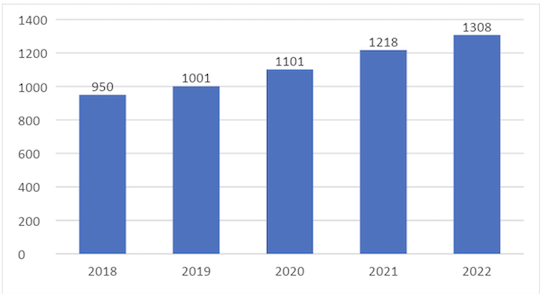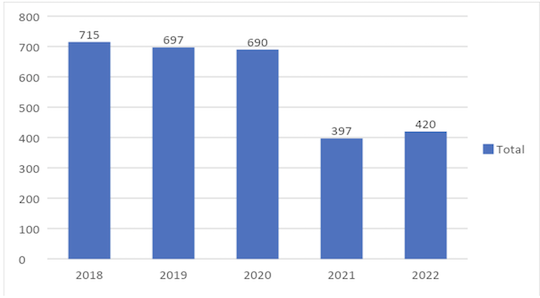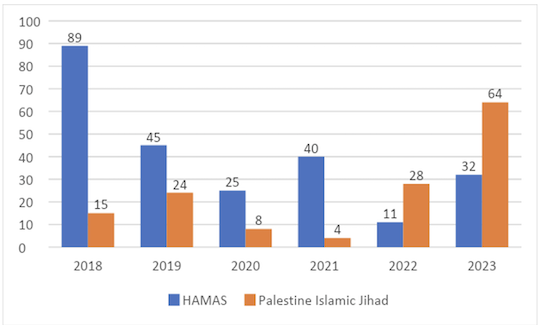Perspective – Playing with Fire in the Middle East: Who are the Winners and Losers of Hamas's Terrorist Attacks?
Perspective – Playing with Fire in the Middle East: Who are the Winners and Losers of Hamas's Terrorist Attacks?
Mahmut Cengiz
Hamas conducted a full-fledged surprise attack on 7 October 2023, while Israelis were wrapping up the seven-day-long Jewish festival of Sukkot. As of 15 October, Hamas's complex coordinated terrorist attacks killedmore than 1,300 Israelis and wounded 3,400 others, while Israel's retaliatory response in Gaza killed 2,215 people and wounded 8,714 others. Hamas was designated as a terrorist organization by the United States and European Union despite its political representation in Gaza. Even though the region is used to armed confrontations and rising tensions over the last decades, the recent Hamas attacks have been likened to the September 11th attacks on Israel. The post-attack period has brought several questions to minds, such as (a) whether the jihadist terrorism and Hamas's attacks have faded over the years, (b) why Israeli intelligence failed to prevent the attack, (c) who the winners and losers are of the attacks, (d) whether Hamas could be a model for other terrorist groups, and (e) what lessons the policymakers should take from the attacks.
Global Jihadist Terrorism and Hamas
The common belief is that jihadist terrorist groups have been defeated globally. The decapitation of the al-Qaeda leader, Ayman al Zawahiri, in Afghanistan in 2022, the last three ISIS leaders in Syria in US military operations in 2019, 2020, and 2021, the ISIS's confinement in Dayr az Zohr province of Syria, and dramatically decreasing number of notable jihadist attacks have suggested that jihadist terrorism does not pose a threat. Moreover, changing US threat analysis that replaces global terrorism with Russia and China's expanding influence has strengthened the common perception that jihadist groups are no longer global threats to world security.
Additionally, terrorism databases report declining terrorist attacks overall in the world. For example, terrorist attacks decreased from 10,167 in 2020 to 8,354 in 2021. However, a specific analysis of the jihadist groups continues to give alarming results. Figure 1 below demonstrates the attacks of ISIS and its affiliated organizations between 2018 and 2022 and shows steady increases over the years. Its attacks rose 37 percent from 2018 to 2022.

Figure 1: ISIS and Its Affiliated Organizations' Attacks between 2018 and 2022
Figure 2 below demonstrates four main active Al Qaeda-affiliated groups, Hay'at Tahrir al-Sham (HTS), Jama'at Nasr al-Islam wal Muslimin (JNIM), al-Shabaab, and al-Qaeda in the Arabian Peninsula (AQAP). The number of these groups' attacks began to decline in 2021 and then slightly increased in 2022. Thus, even though there is a decrease in the number of attacks by al-Qaeda-affiliated groups, it is still too early to undermine these threats. Al Qaeda's settlement and increasing capacity under the Taliban government in Afghanistan makes the organization still a significant threat.

Figure 2: Four Active Al Qaeda Groups (HTS, JNIM, AL SHABAAB, AQAP) between 2018 and 2022
Similarly, Hamas and other jihadist terror groups in the Middle East have also increased their capacities, and Hamas's recent successful attacks brought questions about the failure of Israeli intelligence. Israeli counterterrorism model is based on early prevention, interdiction, and treatment of sources of terrorism. It has been considered successful, given that Palestinian groups have failed to make notable attacks since the early 2010s. However, Israeli intelligence missed the 7 October attacks, in which Hamas pulled off a complex and multifront assault that took months to plan and execute. The combination of air, land, sea, and rocket assault indicated that the circle of knowledge was extensive. Also, the data collected in the first eight months of 2023 by GTTAC (Global Terrorism Trends and Analysis Center) Records of Incidents Database (GRID) terrorism database indicated an increasing risk of attacks in the region. First, Figure 3 below shows the growing number of terrorist attacks and people killed and wounded in these incidents. The steady increase since 2021 has continued, and the first eight months of 2023 recorded a 50 percent increase in the number of terrorist attacks recorded in the Israel, Gaza, and West Bank region.

Figure 3: Incidents in Israel, the West Bank, and the Gaza Strip
According to Figure 4 below, both Hamas and Palestine Islamic Jihad (PIJ) expanded their capacity and were the perpetrators of increasing terrorist attacks in the region. The number of Hamas attacks from 2022 to the first eight months of 2023 rose almost 300 percent. Furthermore, both groups made joint attacks and targeted Israeli forces in the same year.

Figure 4: Incidents by Hamas and PIJ
It should be noted that the last two years' trends recorded the emergence of a new group, the Lion's Den, and an increasing number of al-Aqsa Martyrs Brigade (AAMB) attacks in the region. The AAMB's attacks rose from 6 incidents in 2022 to 31 in the first eight months of 2023. Considering these recent trends, Israeli intelligence's failure to detect the recent assault has left many questions.
Winners and Exploiters
Ongoing armed confrontations have listed a group of regional and international exploiters and winners. The first group in the winner category is Hamas. It has been a question why Hamas has planned these coordinated attacks, knowing well and experiencing the Israeli's harsh punishment and retaliatory attacks. Israel's controversial counterterrorism strategies have received criticisms of being too punitive and violating international laws. These harsh policies have prevented terrorist attacks but caused increasing grievances of Palestinians who live under challenging conditions. Hamas's recent attacks prove how the organization acts as a terrorist organization, and its tactics are similar to how terror groups indiscriminately target civilians. These attacks have brought popularity to Hamas and will bring sympathy to the organization due to the overreactions of the Israeli government. It seems Hamas will get support from the Muslim communities and continue to conduct its terror attacks. The Palestinians in the region will see Hamas as the only group that can defy the ongoing repressions of the Israeli government.
The biggest winner and exploiter is the Iranian regime. It has been clear from the first day of the attacks that Iran has actively been involved in the brutal terrorist atrocities. According to the Wall Street Journal, Tehran helped plan and fund the endeavor with meetings in Beirut. Hezbollah's launching attacks targeting Israel from Lebanon is another indicator of Iranian involvement. Since the 1979 Shah's revolution, Iran has exploited and exported terrorism to protect its paranoid regime. Its foreign policy is based on supporting Sunni terrorist groups wherever they fight against the United States and the Western world. In contrast, it is to arm Shia groups who target Sunni groups in Yemen and Syria. Apparently, Iran seems to be the winner of ongoing conflicts
Another exploiter of Hamas attacks is the corrupt political Islamic leaders. Muslim communities have been repressed in the Sahel region, Myanmar, and China, but these leaders give special attention to the conflict in Israel and Palestine because they know well what the historical conflict between Israelis and Palestinians means for the Islamic world. Corrupt leaders aim to use every opportunity to bring popularity to their leadership and political parties
Jihadist terrorist groups will be another group of winners. The conflicts in Israel and Palestine, Jammu and Kashmir in India, and Myanmar serve as reference cases for these groups who closely follow ongoing armed confrontations, use overreactions and collateral damages to get their people radicalized and recruit more people. It seems ISIS and al-Qaeda will aim to benefit from ongoing confrontations and reemerge in the regions where dictatorial regimes have repressed the Muslim communities.
Those Who Pay the Price
While many benefited from the conflict, others have paid a high price. The first group among those is Israelis, who are exposed to the psychological impacts of the attacks that produce a cascade of detrimental effects and continue to have national and international ramifications. After the 9/11 attacks, many Americans shifted from a perception of personal security to one of insecurity and from a perception of the country as invincible to a perception of the country as vulnerable. It took long years for New Yorkers to return to their daily routines after the 9/11 attacks, and Israelis will be experiencing a similar fear of terrorism in the coming days.
The second group is innocent Palestinian civilians who have been against Hamas but have been exposed to many political and economic grievances under the complete siege of the Israeli government. It seems the Hamas attacks will continue to cause overreactions from the Israeli government. So far, the Israel counteroffensive has included cutting off access to electricity, water, and sanitation, and aggressive bombing has destroyed civilian homes and forced to displace tens of thousands. These bombings have killed civilians, including women and children. It should be remembered that these overreactions plant the seeds of hatred and revenge and settle in the minds of communities that can be carried to further generations.
The image of Islam will also pay the price. The efforts of the Iranian regime that export terrorism, the results of the Soviet's invasion of Afghanistan that recorded the movement of Afghan warriors to al-Qaeda terrorist organization, ongoing political and economic grievances in the Muslim countries, and repressing the groups who are in favor of moderate Islam under current dictatorial regimes in the Islamic world have brought about debates on how Islam is a religion that can be debated in the context of radicalism and terrorism. However, it is a big mistake to put terrorism and any religion in the same context. Islam,
Can Hamas Set a Precedent for Other Terrorist Groups?
Terrorist organizations copy successful tactics and strategies. Any attack that brings more popularity, recruits, and funding is regarded as a successful tactic. Since the 9/11 attacks, it has been rare to see terror groups achieving their ultimate goals, except for the Taliban's use of terror tactics that killed thousands of Afghans and Americans and took over the Afghan government in 2021. Taliban set a precedent for other jihadist groups, and they have seen the Taliban model as an example of achieving their goals. Its model is based on perseverance, using complex terror techniques, getting the support of states sponsoring terrorism, and deploying technological weapons. Similar to the Taliban, Hamas will set another precedent for terrorist groups. Forced to live under strict siege, the group has used every opportunity to get the support of Palestinians. This support brought victory in the elections for the organization. Its close relationships with Iran, Qatar, and Turkey provided arms, explosives, and political support. Its increasing capacity has enabled the organization to make a full-fledged attack.
To conclude, global terrorism still poses a significant threat to the world, and the US is the most substantial actor in the fight against it. Unlike its European partners who act strategically and situationally, the US military operations overseas have strictly targeted the leaders of jihadist terrorist groups. From the early minutes of the attacks, the US condemned Hamas and supported Israeli operations. However, its support should be firmly but not unquestioningly; therefore, it is crucial for the US government to warn Israeli forces to avoid overreactions. Israeli forces should aim to punish Hamas and its resources, not innocent Palestinians. Otherwise, the views of overreactions in social media will only serve the goals of jihadist terrorist groups, raise tensions against the Western world, and harm the efforts of the global coalition to fight against jihadist terrorism. It should be noted that global terrorism can only be defeated with the support of countries where jihadist terror groups originate in Muslim countries.
